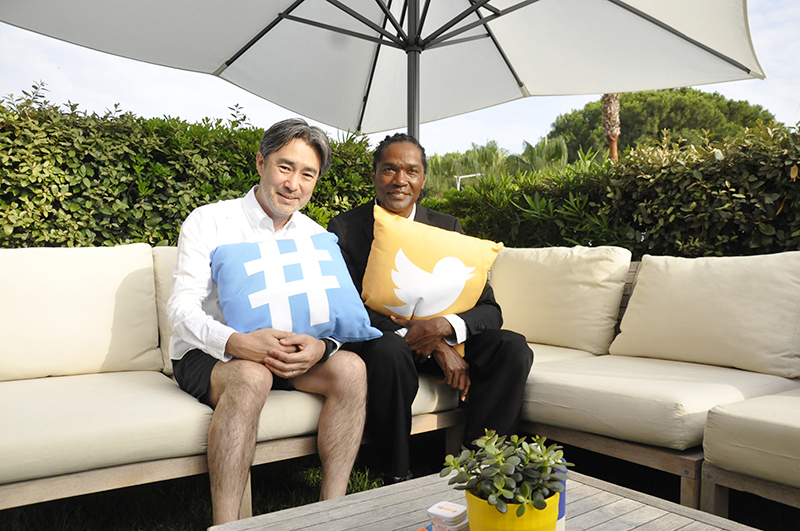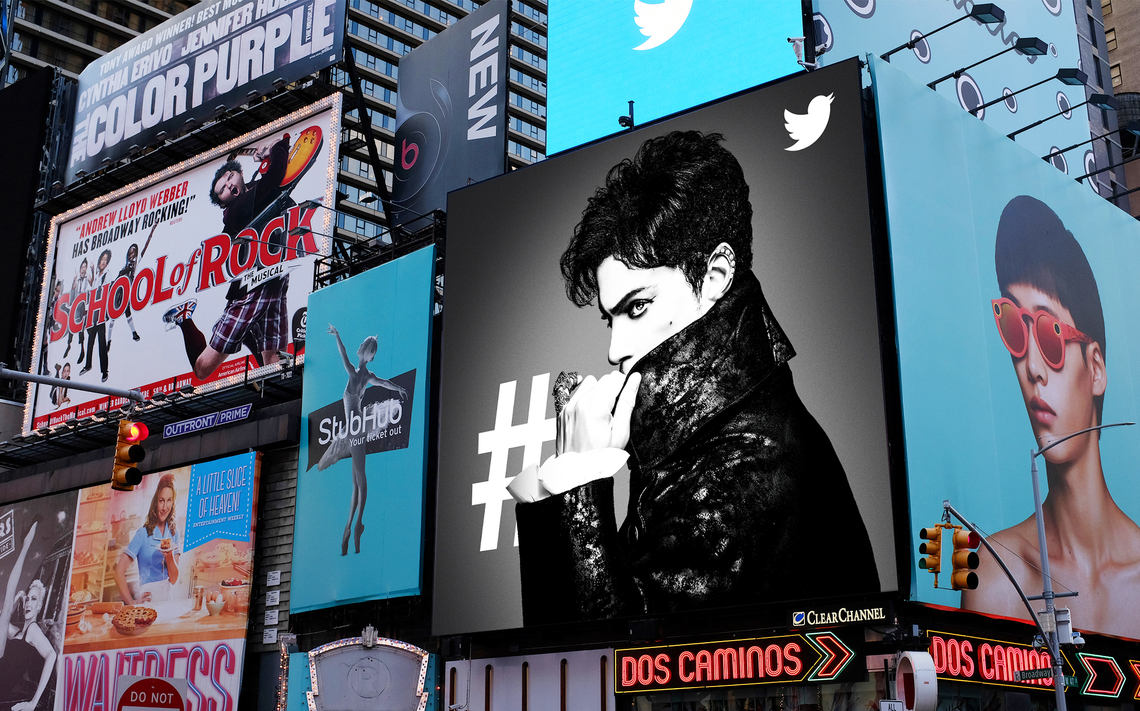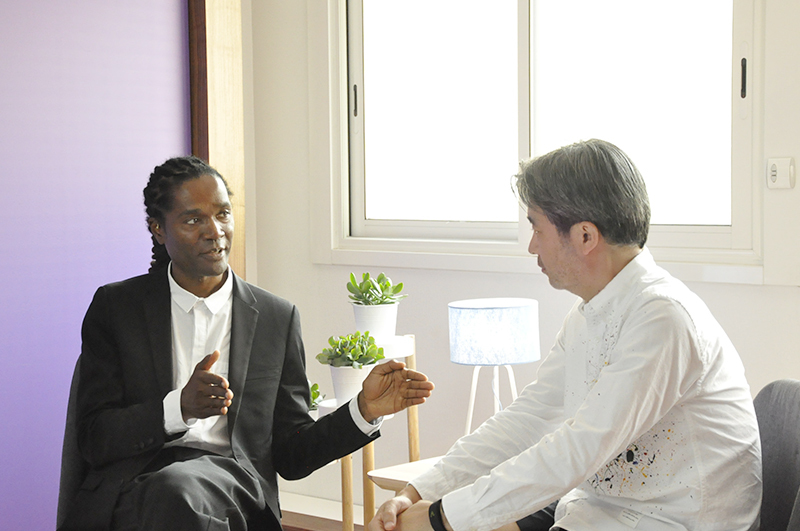Starting this year, Twitter is running a global campaign in both Japan and the US. Leading the creative for both is Jayanta Jenkins, who has worked on projects for Apple (Beats by Dr. Dre) and Nike, and currently serves as Global Group Creative Director at Twitter. At Cannes, Jenkins and Dentsu Inc.'s Mitsushi Abe, who is in charge of Twitter's Japanese campaign, discussed the campaign's objectives and the creative behind it.

Mr. Mitsushi Abe, Creative Director at Dentsu Inc. (left), and Mr. Jayanta Jenkins, Global Group Creative Director at Twitter
The relay-style development of tweets is a common structure that can be deployed globally.
――Please tell us about the campaigns in Japan and the United States.
Abe:The Japanese campaign was designed to dispel misconceptions about Twitter among people in their 30s and 40s who had never used it before. These misconceptions included the idea that Twitter was a platform for communication between individuals or a tool mainly for young people. We wanted to show that it's not a platform where only topics of interest to young people are discussed. So, we created content based on topics that people in their 30s and 40s would be interested in. What about the campaign in the United States?
Jenkin:For the US TV commercial , we strategically targeted digital natives. We wanted people who had used Twitter before but weren't using it much lately to see that Twitter is an easy-to-use and convenient tool. So we used topics like sports and music, keeping in mind scenes that would make people feel it was easy to use and would spark conversation. That's probably the difference from Japan.
What are the key points of each creative?
Abe: TV commercials that unfold with the story and tweets intertwined aren't very common in Japan, so we struggled with how to create them. Then, in April, we received the American version of the storyboard and discovered a structure where people and tweets relayed messages, connecting the whole thing in a circle. We thought, "This is it!" And finally, the script for Japan was complete.
Jenkin: I think the way the tweets are relayed is a common structure that can be used globally. The part where tweets appear simultaneously to simulate a conversation is a wonderful aspect of the Japanese work. I especially like how it properly addresses the roles of men and women.
Abe: We were particular about realism, so we cast actors who are actually dual-income parents with children for the roles of the father and mother. We also focused on realism for the location, avoiding a cool, commercial look. Furthermore, we shot on film rather than digitally.
Jenkin: By deliberately using film, a tool that evokes analog emotions, I felt that there are things that cannot be done digitally. Last year, Twitter's outdoor advertising in the United States also used traditional methods, and I think there are similarities with Japanese works that value emotions that cannot be captured in 4K video and can only be expressed on film.

Twitter outdoor advertising in the United States
Twitter founder Jack Dorsey said, "It moved me."
Abe: From your perspective, Jayanta, do you see the campaigns in Japan and the US as separate entities, or as part of a single global campaign?
Jenkin: I think it's definitely a global campaign, even though there are nuances because Japan and the US each have different messages to convey. When we showed Twitter founder Jack Dorsey the Japanese and American works at the same time, he said he liked both. Jack isn't someone who shows his emotions much, so the fact that he said he was "moved" is an episode that supports this campaign.

Jayanta Jenkins of Twitter (left) and Dentsu Inc.'s Mitsushi Abe
Abe: In Japan, there aren't many campaigns that run globally at the same time. Even for the same product or service, it's normal for the message and approach to be completely different depending on the market. I used to think that wasn't good for branding, but while working on this project with Mr. Jenkin, I had a strong sense that we were creating the same global brand together.
Jenkin: In that sense, it was very easy to work on this project. We placed great importance on how each other felt and were careful not to lose any nuances. It's important to strike a balance between valuing empathy and not forgetting theory. I think all of these things came together to enable us to create a project based on a global perspective.
Abe: I'm very happy to hear you say that. Thank you very much!
――Finally, please tell us about the future of Twitter and Dentsu Inc.
Jenkin: Everything about this Japanese creative project was perfect, from the casting to the music to the story. I think it was the best possible first project for Twitter and Dentsu Inc. Nothing has been decided about the future yet, but there are possibilities. While increasing the number of actual Twitter users is important, this Japan-U.S. project also places great importance on how to build the brand. I'm really looking forward to seeing how things develop from here.
Abe: I really like Twitter. I've been using it since the beginning, even getting an account just one month after Jayant (in May 2007). One of Twitter's core beliefs is "Every voice has the power to shape the world," and I truly believe that. I believe Twitter is a platform that flattens the power dynamics between individuals and organizations. I'm thrilled we could express such a major brand together across national borders, and I'd be honored to continue helping grow the Twitter brand as the Japan lead.
After the interview (Mitsushi Abe)
Mr. Jenkin had just finished a Twitter seminar in Cannes that day. The powerful message he delivered to the audience, "Brands have the power to achieve diversity and inclusion," was highly acclaimed not only at the venue but also around the world.
After our conversation, we received news that we had won the Grand Prix in the OOH category, and I think the Twitter brand had the wind at its back at Cannes this year.
Mr. Jenkins demanded a very high level of quality from the Japanese creative team. He came to Japan himself, was present for all filming and rough editing, and the creators exchanged various opinions directly with each other. Since Japan and the US proceeded with production at almost the same time, a synergy effect was created, with each side referring to the other's details of expression.
The number of Twitter users in Japan continues to grow. We will continue to work on various initiatives to further strengthen this iconic and unique brand.









